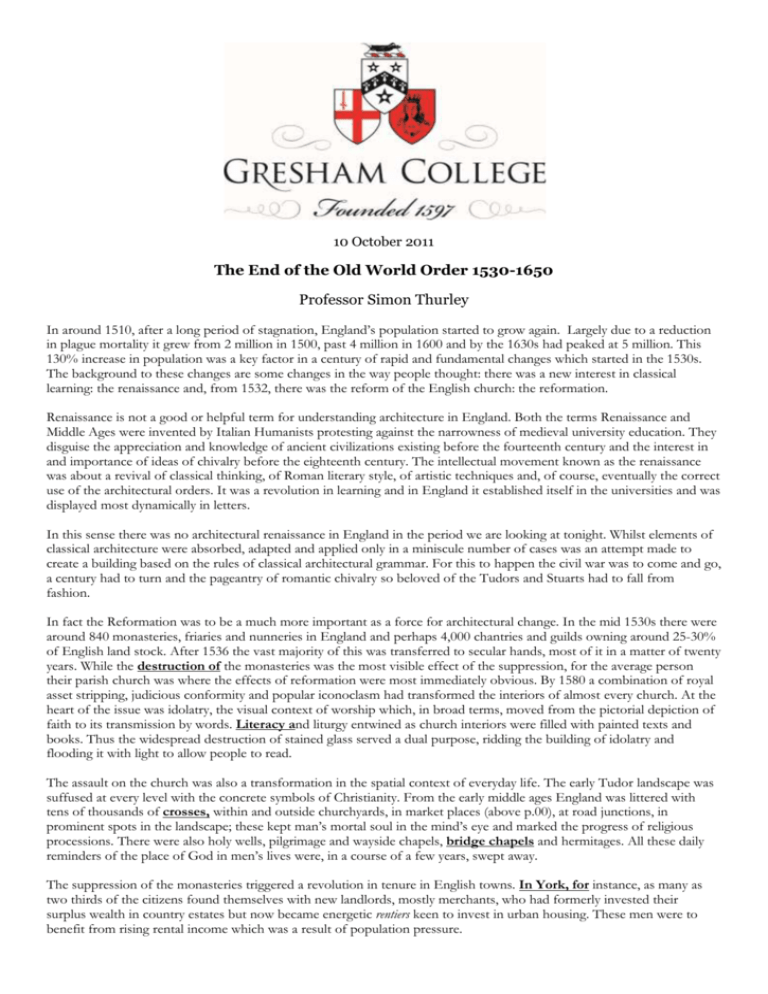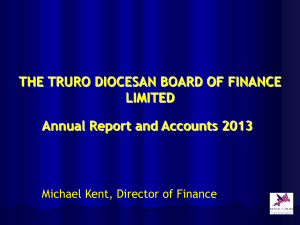Professor Simon Thurley`s transcript
advertisement

10 October 2011 The End of the Old World Order 1530-1650 Professor Simon Thurley In around 1510, after a long period of stagnation, England’s population started to grow again. Largely due to a reduction in plague mortality it grew from 2 million in 1500, past 4 million in 1600 and by the 1630s had peaked at 5 million. This 130% increase in population was a key factor in a century of rapid and fundamental changes which started in the 1530s. The background to these changes are some changes in the way people thought: there was a new interest in classical learning: the renaissance and, from 1532, there was the reform of the English church: the reformation. Renaissance is not a good or helpful term for understanding architecture in England. Both the terms Renaissance and Middle Ages were invented by Italian Humanists protesting against the narrowness of medieval university education. They disguise the appreciation and knowledge of ancient civilizations existing before the fourteenth century and the interest in and importance of ideas of chivalry before the eighteenth century. The intellectual movement known as the renaissance was about a revival of classical thinking, of Roman literary style, of artistic techniques and, of course, eventually the correct use of the architectural orders. It was a revolution in learning and in England it established itself in the universities and was displayed most dynamically in letters. In this sense there was no architectural renaissance in England in the period we are looking at tonight. Whilst elements of classical architecture were absorbed, adapted and applied only in a miniscule number of cases was an attempt made to create a building based on the rules of classical architectural grammar. For this to happen the civil war was to come and go, a century had to turn and the pageantry of romantic chivalry so beloved of the Tudors and Stuarts had to fall from fashion. In fact the Reformation was to be a much more important as a force for architectural change. In the mid 1530s there were around 840 monasteries, friaries and nunneries in England and perhaps 4,000 chantries and guilds owning around 25-30% of English land stock. After 1536 the vast majority of this was transferred to secular hands, most of it in a matter of twenty years. While the destruction of the monasteries was the most visible effect of the suppression, for the average person their parish church was where the effects of reformation were most immediately obvious. By 1580 a combination of royal asset stripping, judicious conformity and popular iconoclasm had transformed the interiors of almost every church. At the heart of the issue was idolatry, the visual context of worship which, in broad terms, moved from the pictorial depiction of faith to its transmission by words. Literacy and liturgy entwined as church interiors were filled with painted texts and books. Thus the widespread destruction of stained glass served a dual purpose, ridding the building of idolatry and flooding it with light to allow people to read. The assault on the church was also a transformation in the spatial context of everyday life. The early Tudor landscape was suffused at every level with the concrete symbols of Christianity. From the early middle ages England was littered with tens of thousands of crosses, within and outside churchyards, in market places (above p.00), at road junctions, in prominent spots in the landscape; these kept man’s mortal soul in the mind’s eye and marked the progress of religious processions. There were also holy wells, pilgrimage and wayside chapels, bridge chapels and hermitages. All these daily reminders of the place of God in men’s lives were, in a course of a few years, swept away. The suppression of the monasteries triggered a revolution in tenure in English towns. In York, for instance, as many as two thirds of the citizens found themselves with new landlords, mostly merchants, who had formerly invested their surplus wealth in country estates but now became energetic rentiers keen to invest in urban housing. These men were to benefit from rising rental income which was a result of population pressure. The profits from renting were re-invested in more new buildings accelerating a process that had begun in the late fifteenth century when, in many towns, buildings for rental had already begun to be constructed more sturdily. After the 1540s stone walling and tiled roofs were much more common, most new houses were of two stories with masonry chimney stacks, stone hearths and newel stairs with attached brick cess pits. Merchants rebuilt and modernised their own houses between the 1530s and the 1570s. Many open halls with central fires were replaced by rooms on two stories with chimneys, new suites of smaller rooms were constructed and the larger rooms had impressive fireplaces and plastered and beamed ceilings. The Reformation also had enormous implications for education overthrowing the church’s monopoly of public life and creating a huge demand for lay administrators and professional men. Vast transfers of land required legal literacy amongst landowners; aspiring new men wanted their children to be literate and numerate; the gentry and aristocracy wanted to master classical knowledge as a gentlemanly attribute and the protestant Godly believed that education would guard against ignorance, profanity and idleness. The effect of this was a huge increase in formal education at both a local level and at the universities. By 1640 half the population of London and a third of rural men could read and at least 2½% of 17 year-old males were going to university, a proportion higher than at any time before the Second World War. By the 1530s monasteries, hospitals, chantries and collegiate churches provided formal education for perhaps as many as 5,000 children under 15. Education never having been a state responsibility providing an alternative to this arrangement was not a government priority but pressure after the dissolution of the chantries and corresponding royal pragmatism led Edward VI, from 1550, to create a number of new ‘free’ grammar schools with endowments from former chantry lands. In all there were 26, half of which had originally been chantry schools. The movement continued under Elizabeth I, but only with royal approval, not with royal cash. The Elizabethan schools were set up by civic action, much like the chantries that they replaced, indeed perhaps as much as a quarter of all Elizabethan charitable giving went towards school foundation. The model for these new schools was probably the school built by Dean Colet of St. Paul’s Cathedral, London, in 1512. This building no longer exists but comprised school rooms, chapel and attached houses for the teaching staff. Thus the children and their masters formed a distinct community within a single complex. Guildford Grammar School was built in 1557-86. This comprises a small courtyard with the main school room on the south side; the houses for the master and usher are attached on the east and west and on the north side there is a small library. The children were taught in the ground floor room on the north, sitting on forms, with their master at the end of the room on a shallow dais. The room above has a series of splendid fireplaces and was most likely used by the townsfolk as a civic space. Borders may have been lodged in the attics. The early seventeenth century educational boom equally affected higher education and benefited not only the aristocracy, or even the merchants and gentry, university places were taken up by the sons of the humble and poor in large numbers. Money poured into collegiate education, the rich funded no fewer than 500 new scholarships as well as lavish new buildings and endowments to maintain dons in style and comfort. This was a period of intensive construction for the colleges of Oxford and Cambridge and the Inns of Court. Middle Temple Hall, London’s finest surviving Elizabethan interior, is a case in point. The vast space slightly shorter than the hall at Hampton Court is no less wide and vaulted by a great double hammerbeam roof symbolic of the ancient origins and authority of the inn. Of all these creations the most important and ambitious was the new quadrangle built at St. John’s College, Oxford, by Archbishop Laud. The man who is credited with its design is Adam Browne, Laud’s architect joiner, but he may have been relying on drawings from Antwerp, as the design of the frontispiece has close links with contemporary buildings there. The quad has defied attempts at stylistic categorisation due to its easy mix of fan vaults, battlements and hood mouldings with Tuscan arcades, pediments and an aediculed niche. But Laud, his architects and contemporaries admired this rich and harmonious composition. The east and west courtyard elevations were deliberately emblematic: the busts of the Virtues and Arts proclaim Laud’s belief in Oxford’s medieval curriculum and the frontispiece, based on Counter-reformation church facades in Paris, combine the arms of the archbishop and images of the king and queen. Here was the ultimate statement of belief in the Anglican Church, a belief for which both Laud and his king were to perish. Amongst England’s towns London’s wealth rapidly outstripped all others. Its money first came from trade in cloth: by 1530 it had 85% of the country’s overseas trade, and by 1543 London’s tax contribution was as large as all the other towns in England combined. In the fifteenth century the main trading place for London merchants was in Lombard Street out in the open. In 1531 Antwerp, northern Europe’s commercial hub, rebuilt its Bourse demonstrating the huge benefits of a purpose-built indoor trading centre. Although Henry VIII wanted London to follow suit, it was not until 1564 when Sir Thomas Gresham, London’s wealthiest merchant and Royal Agent in the Netherlands to Queen Elizabeth, offered to build one at his own expense. It was constructed in 1566-7 under the supervision of Henry van Paesschen possibly to designs by Cornelius Floris; the concept was a fifteenth century one, an arcaded courtyard but in style the arcades, where the merchants conducted their business, were round-headed and rested directly on columns without any entablature. A sturdy tower rose over the complex as at many a Netherlandish town hall, in this, in 1599, was installed a clock with four faces which, together with a bell, marked the end of daily trading. During the last quarter of Elizabeth I reign London had become the engine of the national economy and the fuel that drove it was shopping. The Royal Exchange included two floors of kiosks above the arcades selling luxury goods, shoes, watches, silks, gloves and more. These were only 5ft by 7.5ft but could generate huge profits for their tenants. This building was a whole new concept in shopping: elite customers were not forced to walk the dirty streets but could browse in comfort and relative privacy. Other changes to the comfort of the rich had an equally big impact. From the early middle ages anyone with any means travelled around London by river but in the 1550s there was a social revolution which had very far reaching impacts. The invention of the carriage was a holy grail as for centuries people had been trying to devise a vehicle that could move briskly without pulverising its occupants. In the 1550s a new type of carriage appeared in England, by 1600 their use was no less than a craze, and by 1620, coach making was one of the most lucrative industries in the capital. Before the introduction of the carriage there were few horses stabled in London, but from the 1560s for every carriage there had to be at least two horses. The aristocratic houses along The Strand, like Somerset House, created separate entrances and yards for their stables, but providing stabling for thousands of lesser houses was challenging. What was to become the standard solution for London houses for the next 250 years was invented by Inigo Jones. In Covent Garden a service road was built behind the terraces. Between this and the backs of the mansions was a garden and a stable, a mews, in fact. These mews buildings had coach houses with big double doors and stables for two to four horses. Above was space for a hayloft and accommodation for the grooms. The proliferation of coaches led to a drastic improvement in the road network round London: for twenty to thirty miles outside the capital the roads were now excellent. so it was possible to go out to Richmond or Greenwich for dinner and return the same evening and, of course, it was also possible to stay outside Westminster or the City in the calm and clean air of a suburban village whilst having all the attractions of the capital within easy reach. In fact by the 1630s most aristocrats lived in the suburbs rather than the city. The aristocratic suburban house was a hugely significant development enabling landowners to exchange the territorial obligations of the countryside for the social allure of the city within an affordable budget. At first these houses were not architecturally distinct, a surviving example is Sutton House, Hackney, built for the rising Tudor statesman Sir Ralph Sadleir in c.1535; it is barely distinguishable from any contemporary merchant’s house or a small country mansion. But from the 1580s these houses began to develop a new type of plan known as the double pile. This simply means that instead of being only one room deep there were two ranges of building back to back. Triple pile houses were three rooms deep. These houses were much more compact and abandoned the linear planning of earlier houses with something spatially and socially more complex. The plan of these villas, for they must be called this, derived ultimately from towns where all but the largest houses were built on deep and narrow burgage plots (above p.00). The obvious solution to this constraint was to construct a central spine wall containing chimney flues and to erect ranges of building on either side. A big merchant’s dwelling such as Clifton House in King’s Lynn, Norfolk was effectively already a double pile by 1400. such houses didn’t have rooms arranged in a single line and adopted more complex plans. One of the earliest and most radical villas was Charlton House, Greenwich, built 1607-12 is a remarkable survival of this type of building. Its builder was Adam Newton, Tutor and secretary to the Prince of Wales. It too has a remarkable plan for the great hall runs from front to back, rather than from side to side with double pile blocks either side. These urban and suburban mansions were of importance because they pioneered a new way of living with different relationships between servants and masters, landlords and tenants. It was a cheaper, more private and practical way to live with warmer, more manageable rooms disposed in such a way that the family and guests could move about independently from the servants. Printing, of course, revolutionised the spread of knowledge, and this was particularly important in architecture as it was possible for the first time to distribute thousands of copies of line drawings cheaply and quickly. Single sheet designs of ornament were inspiring designs by English craftsmen from the 1460s; Generally these prints came from Flanders or Germany, as indeed did many of the best craftsmen and the few sheets that did come from Italy dried up in the wake of the Reformation. Yet despite this the single most influential printed source for sixteenth century English architecture was, in fact, Italian: Sebastiano Serlio’s Regole Generali Architettura. This was a new concept in architectural writing profusely illustrated. Crucially Serlio illustrated five orders of architecture: Tuscan, Doric, Ionic, Corinthian and Composite, and these became the canon of classical architecture from his time on. In 1611 Robert Peake published an English edition of Serlio and this, together with thousands of reprints, copies and plagiarisms, ensured that it was widely available right down the social scale. Individual features and designs from these books were copied in detail, an early appearance of Serlio’s influence was a ceiling design pattern used on the chimneys of Somerset House - an example of the magpie attitude to the language of the orders; they were effortlessly incorporated into the existing vocabulary of English architecture. As well as adopting the four orders as a new decorative element there were occasional attempts to use them in a more correct manner. As far as we know the first of these was the strand elevation of Somerset House, London, the great town palace begun by King Edward VI’s uncle, Edward Seymour, Protector of England. Seymour presided over a socially and religiously radical government and he, himself, was interested in the avant garde. Most of all he was a soldier and the classical elements were symbolic of Somerset’s military status: the centrepiece of the Strand façade was a great triumphal arch suitable to a military hero. From this point on well into the 1610s both houses and institutional buildings were entered by gatehouses or porches sporting a tower of orders such as at Kew Palace. But until the 1640s the underlying principles of English architectural design were, for want of a better word, gothic. The architecture of the orders played only a minor role and even then one that principally fed the English passion for surface decoration. This passion was boosted from 1510 by the importation of other new streams of ornament. In the 1490s, Italian painters discovered the buried remains of the Golden House of Nero in Rome containing complete painted ancient Roman domestic interiors. These designs had an impact in England from the 1510s and continued to be popular for the rest of the century, although they ceased to be the height of fashion by 1560. By this date another craze gripped designers: strapwork, most prominently first seen in the Gallerie François Premier at Fontainbleau. These were borders of writhing and twisting leather belts or straps which developed faces, animals, buckles, and studs to become a bizarre and comic world similar to that created by Bosch and Brueghl in painting. All these new sources of design were complimentary to the existing decorative vocabulary of English architecture, especially Heraldry. This was hugely important in a society where the newly rich wanted to acquire the patina of age.: the Zouche family at their house at Bramshill, Hampshire encrusted the hall screen with forty-nine painted heraldic shields and, in anticipation of their continuing dynasty, a further twelve blank ones. Heraldry should not be seen in opposition to the classical orders for the orders were, in effect, an extension of the heraldic mindset. Both heraldry and the orders were based on strict rules, governed by geometry, symmetry and balance, and of course both were emblematic speaking of the place of the owner in society. At the top of this social order was, of course, the king. Before 1530 Henry VIII was not much interested in architecture and England’s greatest builder was also its first minister Thomas, Cardinal Wolsey. Wolsey was the last in a long line of church-statesmen, low born men catapulted to great power and wealth by personal talent and royal favour. These men built to match their status which, in Wolsey’s case was not only Archbishop and Cardinal but also Papal legate. Wolsey maintained houses and household appropriate to his wealth and status. Such men were expected to live on a regal scale; their lifestyles were a matter of national pride as much as personal vanity. Princely consumption was thus a virtue not a vice; it was part of the proper order of society. Wolsey had half a dozen houses including a substantial town house, York Place in Westminster and two country houses Hampton Court and The More, Hertfordshire. These houses reflected the requirement of a great medieval statesman prelate who had to live his life in public, attending mass in his own chapel, receiving petitioners, ambassadors and foreign monarchs in his lodgings and processing everywhere pompously in state. By the late 1520s Henry VIII’s interests had started to shift from the outdoor pursuits of his early adulthood to more intellectual preoccupations of middle age. He was in love with a cultured and vivacious younger woman and in 1529 began to acquire the houses of his fallen minister Wolsey. Soon his coffers were to be swelled with the wealth of the monasteries. England was set to see one of the greatest periods of royal building for two centuries. In 1529-30 the king began to adapt Wolsey’s formwe houses of York Place and Hampton Court to be the two most important royal houses of the sixteenth century. These buildings were built in an eclectic style underpinned by chivalry. With their turrets, gilded vanes, brightly painted walls, coats of arms, badges and heads of Roman Emperors Henry’s palaces were visions of the court of chivalry with a knightly king at their head. Henry had been obsessed with knighthood since adolescence, much of which he spent jousting and his palaces can be seen as a chivalric stage set, hurriedly thrown up for the tournament that was his life. Stylistically the culmination of this was the palace of Nonsuch, Surrey, begun for his son and heir Edward in 1538. The house was of two courtyards entered by gatehouses, just like Hampton Court, but its inner court was panelled outside and in with slabs of moulded stucco with scenes from mythology and classical history. The stuccos melded with a typically gaudy Henrician mix of brightly coloured turrets, gables, flags and bays. In 1538 Henry became convinced that a Catholic crusade to invade England was inevitable and commissioned a refortification of the English coast from Lowestoft in the east to Milford Haven in the west. Henry himself took control of the design supported by a small group of military minded courtiers. The executing architects were from the office of works, the same men who had just completed Hampton Court and started on Nonsuch. By the end of 1540 the extraordinary number of 24 new fortifications had been completed and garrisoned. Henry’s coastal fortresses were artillery forts, magnificent killing machines designed to emit the maximum number of cannon and musket balls to prevent an enemy gaining an anchorage for invasion. They were not designed to withstand a land-based siege nor heavy bombardment from the sea. So each had a tall cylindrical keep surrounded by tiers of roofed rounded, hollow bastions designed for mounting teirs of cannons. They represented terrifying firepower. Henry’s forts, although never pressed into significant active service, and with continual maintenance and modification, were the backbone of England’s costal defences throughout Elizabeth’s reign and through the Spanish Armada. So much for royalty, what about the courtiers, what were they building? The old nobility did not generally build country houses as they already had them. It was the new men who built, generally those enriched by royal service, the law or trade. These men grew rich not though salaries (which were negligible), but through the profits of office and through gifts from the Crown. James I and Charles I gave away gifts and favours worth £3m during their reigns. The greatest Elizabethan builder was William Cecil, Lord Burghley the Lord Treasurer. With the Treasurership came unimaginable wealth and part of this Burghley invested in three important houses, one in Westminster and two in the country: Burghley, Northamptonshire and Theobalds, Hertfordshire. The west front of Burghley, designed by one of the leading designers from the royal Office of Works, Henry Hawthorne, emphasised traditional architectural and social values with gatehouse, towers, turrets and bay window, inside the great hall has a hammerbeam roof. The courtyard, however, is a masterly assemblage of classical elements focussed on an extraordinary tower of the orders. While more correct in its deployment of the orders than most later Elizabethan buildings, Burghley is still a melange of classical elements rather than a house that could have been built in contemporary France where adherence to classical rules was de rigeur. Of course Burghley was exceptional and most of the great Elizabethan and Jacobean houses like Audley End, or Hardwick Hall were very distant from ordinary people’s reach. As I explained in my last lecture from 1400 to 1530 England was dogged by low population, people were scarce and land was plentiful. Villages shrank, landholdings increased in size, rents were lower and tenure was more secure in fact most villages were smaller in 1520 than they had been in 1320. This trend was reversed in the early 1500s. Population growth resulted in rising food prices and higher agricultural rents and villages started to grow once more. Slowly at first, but with increasing rapidity after the 1570s, the food market expanded and diversified. London, in particular, became a source of ravenous demand and commercial farming began to intensify. During the seventeenth century almost all houses in the countryside were working farms and increasing profitability led to large numbers of these being rebuilt. The most important advance was the control of smoke, first by the introduction of smoke hoods then by the construction of chimneys and fireplaces. It is surprising that the Romans, with all their sophistication and invention, did not invent a fireplace with a flue and chimney. It is not known when the first fireplaces were built in England, although it is likely that Anglo Saxon royalty would have had them. The earliest surviving examples are in the White Tower and Colchester Castle. However they become increasingly common in high status houses from the from the 1130s, but not common in ordinary houses till the 1530s. As a result of not needing to be open to the rafters to let the smoke out, by the 1630s, most small houses and cottages had upper floors. These changes led to the development of two dominant house plans. In the uplands a preference for the retention of a symbolic hall led to a plan centred on a cross passage on one side of which was a kitchen and on the other two rooms, one heated by a chimney stack. Much more popular, however, was the lobby-entry plan which was a tworoomed rectangular house with a central chimneystack on one side of which would be the entrance door in a lobby, and on the other the stairs. Although originally popular in areas of timber framing (utilising brick for the chimney) it in due course became the most common sort of small house over much of England and was the precursor the two-up-two-down that continued into the twentieth century. Throughout the hundred years from the dissolution of the monasteries until the civil war ideas of chivalry, knighthood and the associative power of gothic architecture dominated building in England. In many spheres the period 1530 to 1620 was one of exuberance and extravagance, a period of voracious conspicuous consumption and spendthrift patrons. From the reign of Edward VI it was as if all the architectural energy and flamboyance of the church and crown were channelled into the buildings. And this was the fundamental change - from an architecture that was continually renewed and invigorated by the interplay between ecclesiastical and secular modes to one that was entirely secular being fed by new streams of decoration mainly from abroad. ©Professor Simon Thurley, Gresham College 2011





